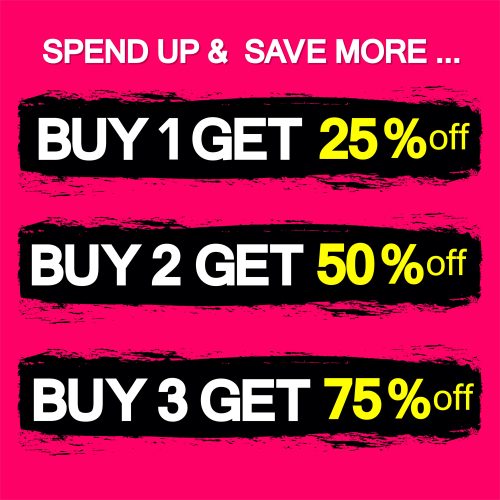
Who wouldn’t want to acquire a coveted product during a “Sale” that lets you pay a price that is less than the usual? Every sensible customer would!
It’s a feel good situation that makes them happy being associated with the brand. The discounted price may also give you an advantage over your competition. There are many shoppers who look out for these special events and plan their purchases at these “Sale” times!
The merchant may choose to call it a “Discount” or a “Deal” or an “Offer” or a “Sale” or by another name of his choice but ultimately, the goal is the same – to entice customers to buy. Apart from the larger sales and revenue numbers, such events are also expected to bring in more customers/ traffic to the store and facilitate in a quick clearance of stock and inventories.
Being Mindful about Discounts

During the “Sale” event, there is likely to be a growth in the topline revenue numbers, and that is wonderful news. However, merchants also need to keep a watch on their bottom line numbers and make sure that they don’t run into losses by lowering the price of products/ services too much in an endeavour to grow sales.
It’s all about striking the right balance and this requires a good amount of planning. For the business to be able to remain profitable despite the price cuts, the merchant must have a good understanding of the gross margins and markups associated with the business. This, along with all fixed and associated costs will allow him to calculate the breakeven price levels for the products he carries.
Once there is clarity on these numbers, he would know the extent of discounts that he can offer his customers without having to make any losses.
The “Sale” must also be positioned and marketed strategically. The reduction in prices should not create the impression among prospective customers that the business is trying to dispose of their lower quality products by selling them at reduced prices. This is important as it may otherwise end up damaging the brand image which is totally undesirable.
Different Discounts that you could Offer

What is the reason behind your decision to discount? What is your objective and goal?
Is it just to grow revenues and improve your financial situation and cash flow, or is it to clear unsold stocks to make way for new inventories, or is it greater footfall and new customer acquisition that you are looking at?
The answers to these questions can help the merchant decide on which of the many discounting approaches he should choose.
Special Event / Seasonal Discount

These shopping events, often recurring and are planned around holidays (eg. summer sales) and festivals (Christmas, Lunar New Year, Diwali) or even special discounting days like Black Friday or Cyber Monday. They are announced well in advance and are strategically marketed to customers who often plan their purchases at these events to catch a bargain.

Stores usually enjoy greater traffic and footfall at such events and offering discounts is a smart way to grow revenues at these times. Such seasonal discounts also provide the merchants an opportunity to move out of season stocks (clearing winter wear during the summer sale) and make way for newer “in season” items.
Bundled Discount

Putting a couple of related products together (as a bundle) and offering a lower price for the entire bundle (vis a vis when bought individually) is the basic premise of this kind of discounting.
If the main objective of your sale is to move slow moving stocks and make way for a new product range then Bundling Discount is a great idea. This will allow you to bundle the slow moving product along with a more popular one and make it appear attractive by offering a discount on the total package.
Bundling together complementary products is a smart cross-selling strategy too and is helpful in increasing the customer’s average order value.
Buy One Get One Free

A bit on the same lines as a Bundled Discount, here, you are offering two items for the price of one and it is too attractive an offer for most customers to refuse! The two items may or may not be identical.
Very often the merchant chooses to give away a product that has not done so well by pairing it with a popular (and high margin) product. This gesture gives customers a good feel of enjoying something free while for the seller is a great way to clear stocks of a not so popular product.
Volume Discount

If the primary goal is to sell more, be it to clear inventory or increase the average order value per customer then try offering Volume Discounts to your customers. This is based on the principle of economies of scale which helps spread out costs over a larger number of goods sold, thereby offering better margins to the seller.
The merchant could pass some of the gains to the customer by charging lower prices (ie. giving discounts) based on the volume of goods purchased. Bulk orders get larger discounts which can often encourage customers to buy more to pay less less per item.
Prepayment Discount
Merchants can offer small discounts on prices for products/ services that are paid in advance by the buyer. This works well for products/ services that are used by the customer regularly (eg. pay up for 10 yoga sessions and get to enjoy 13).
This helps the merchant to collect payment upfront and is especially helpful in managing their cash flow and finances apart from acquiring a captive client. For the customer, the lure of the discount (3 free classes) is often greater than the pain of paying in advance for a recurring activity – something that they would be sure of using for again and again. Hence it is a win-win situation for both.
Free Shipping

This is another discount that the merchant can provide to the customer and is highly recommended. Most shoppers look out for Free Shipping/ Delivery, and would often abandon their carts at the checkout page unless assured of free shipping.
While the customer feels good not having to pay for his goods being shipped to him, in order for the merchant to be able do so, he needs to make sure that his product margins are wide enough to absorb the additional shipping costs!
Otherwise, the smart way out is to have a minimum order level to avail the benefits of free shipping. The lure of availing free shipping can often help increase sales and average order value.
In Conclusion
- Merchants often plan events with “sales” and “offers” in an endeavour to grow their revenues while customers look forward to them as it allows them to buy the product at a lower price.
- Every “Sale” needs to be planned and marketed well, keeping in mind important numbers like margins and break even values in order to make it a success.
- The choice of the discount strategy will depend on several factors including your products, customers and price points and ultimately on the goal and objectives of your “sale”.
- The key to success lies in striking the right balance – that of growing sales by reducing prices without erasing all profits. And doing this while keeping the brand value intact.

For more ideas on Selling Online, you could look up
https://blog.goshopmatic.com/5-evergreen-online-sales-tips-to-skyrocket-your-online-sales/
https://blog.goshopmatic.com/ideas-to-improve-the-average-order-value-on-your-webstore/


